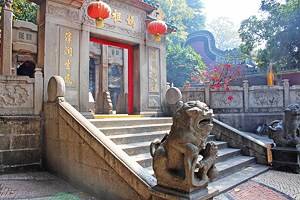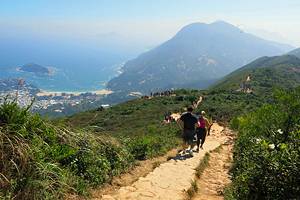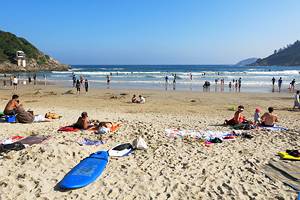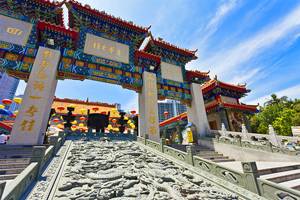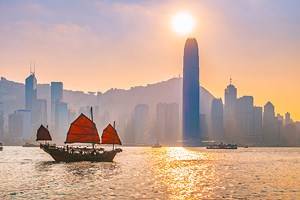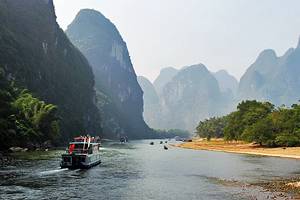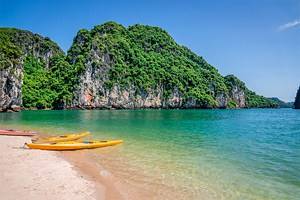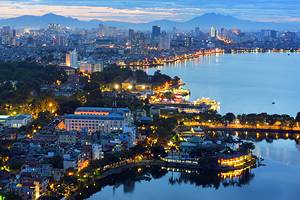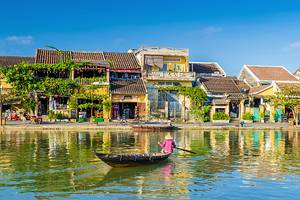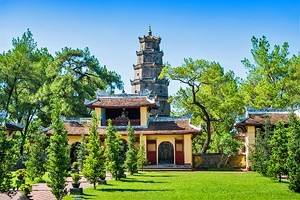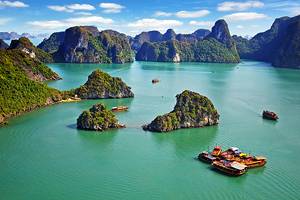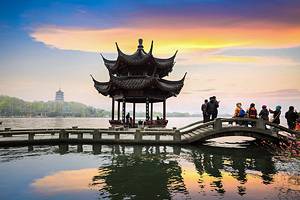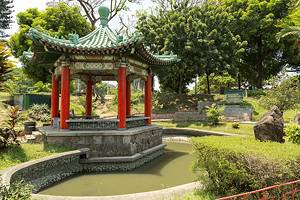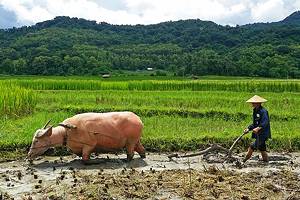Attractions & Things to Do in Macau
Authors Lana and Michael Law love visiting Macau for the sights, sounds, and tastes of this wonderful island.
Macau is a little slice of Portugal deep in the heart of the Far East. It seems hard to fathom that only 60 kilometers from the urban jungle of Hong Kong, well-preserved colonial architecture and cobbled streets exist and wait to be explored.
Take a stroll through the bustling streets up to the ruins of the cathedral, and you'll see the city's rich past everywhere. It's no surprise that the historic center of Macau has been included in the list of China's most significant World Heritage Sites.

The main attractions and tourist-focused things to do are primarily located on the mainland and relatively close to one another. Getting around here is easy, and you can explore many of the sites on foot, walking through the twisty streets.
The entertainment areas and massive hotels are clustered along the waterfront and also on the island of Cotai. Be sure to pick up a tourist map of Macau to orient yourself, as the streets rarely run on a grid pattern, and it's easy to get turned around.
With the recent opening of the new 55-kilometer Hong Kong-Zhuhai-Macau Bridge, the world's longest, you now have the choice to drive or take a high-speed ferry to Macau from Hong Kong. You can visit Macau from Hong Kong as a day trip, but it's best to plan a night or two to fully explore the region. Find the best places to visit with our list of top attractions in Macau.
- Visit the Ruins of St. Paul's
- Stroll through Senado Square
- A-Ma Temple
- Fortaleza do Monte: Home of the Macau Museum
- The Maritime Museum and Fisherman's Wharf
- Jump off the AJ Hackett Macau Tower
- Take the Family to the Giant Panda Pavilion
- Explore the Guia Fortress
- Coloane Island and Hac Sa Beach
- Take a Day Trip to Taipa Island and Taipa House
- Kun Iam: The Temple of the Goddess of Mercy
- Ride the Free SkyCab at Wynn Palace Resort
- Best Time to Visit Macau
Visit the Ruins of St. Paul's

Highlights: Incredible views, the remains of a 17th-century church, a fun and lively vibe
All that remains of St. Paul's Cathedral, once considered the finest Christian building in the Far East, is its imposing Renaissance façade, a Macau landmark standing at the top of a broad flight of granite steps. After the destruction of the first church by fire in 1601, a new one was completed in 1637, modeled on the church of the Gesù in Rome and constructed by Christians driven out of Japan.
The church was destroyed by a typhoon and fire in 1835, but its remaining façade still displays a little of the cathedral's former glory. Notable features include an inscription above the doorway dedicating the church to the Mother of God, figures of Jesuit saints, and a profusion of relief ornaments.
Just around the corner is the beautiful Travessa da Paixao, also known locally as Love Lane. This is a narrow street, with beautifully restored pink-colored buildings, and a favorite of photographers.
Stroll through Senado Square

Highlights: A UNESCO World Heritage site, Neoclassical buildings, street markets, unique patterned pavement
In the historic heart of Macau, Senado Square (Senate Square) is a delightful pedestrian area and where you will likely start your visit to Macau. Highlights include the impressive old Senate building, now occupied by the Municipal Council and widely regarded as the finest example of Portuguese colonial architecture in Macau.
Built in 1784, the building's exquisite façade was added in 1870, and the whole building was completely restored in 1940. Interior highlights are the Council Chamber with its rich wood paneling and the Senate Library with its more than 50,000 rare manuscripts, some more than 500 years old.
The square is also a great place to visit for shopping and dining in restaurants featuring European and Chinese cuisine. It's also home to a number of other tourist attractions, including the 17th-century St. Dominic's Church.
A-Ma Temple

Highlights: The oldest Taoist temple in Macau, amazing sculptures, wonderful view from the top
Dedicated to the goddess Matsu, the splendid A-Ma Temple (Templo de A-Má) was built on the Macau Peninsula in 1488 and was the inspiration for the renaming of the city by the Portuguese a few decades later. Part of Macau's UNESCO Historical Center, this Buddhist temple is one of the city's most important religious sites and is well worth exploring.
Divided into six easily accessible sections — the Gate Pavilion, Prayer Hall, Memorial Arch, Hall of Benevolence, Zhengjiao Chanlin, and Hall of Guanyin — this temple features numerous interesting things to see, from its many fierce-looking stone lions and statues of the goddess Matsu to shady spots to stop and contemplate the serenity of the temple grounds, as well as spectacular views over the bay.
A-Ma temple is a short cab ride or about a 20-minute walk from Senado Square. A visit here can be combined with a stop at the Maritime Museum.
Fortaleza do Monte: Home of the Macau Museum
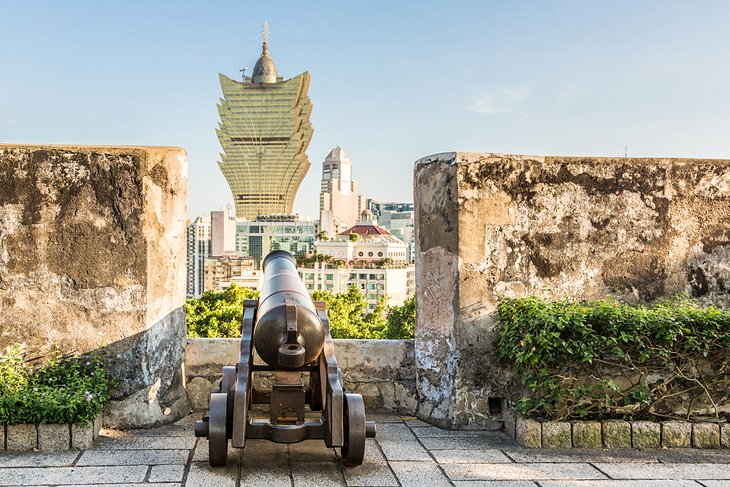
Highlights: Wonderful views, a 16th-century fort that's fun to explore, a museum showcasing Macau's past
Built in 1626, Fortaleza do Monte was for many years the hub of Portugal's military presence in this part of China, eventually serving as the governor's residence, a role it performed until 1749.
Today, this former fortress houses the three-story Macau Museum, dedicated to the archaeology and anthropology of Macau with an emphasis on how the Chinese, Portuguese, and Macanese have come to live and work together.
Also worth visiting is the Mount Fortress Garden, a welcome respite with its pleasant moat-like pond and flower beds, and the Moorish-style Mansão Evocativa de Sun Yat-Sen, a mansion built in memory of Sun Yat-sen, founder of the first Chinese Republic. Another related site is Sun Yat Sen Park with its beautiful gardens, a Victorian greenhouse, and an aviary.
Address: 112 Praceta do Museu de Macau, Macau
The Maritime Museum and Fisherman's Wharf

Highlights: Interactive and interesting displays plus a restored dragon boat, sampan, and fishing smack
Occupying a modern building opposite the A-Ma Temple, the excellent Maritime Museum (Museu Marítimo de Macau) hosts numerous displays, including a comprehensive collection of material on Macau's maritime history, model ships, and fishing equipment.
Also of interest are exhibits illustrating the development of nautical and meteorological instruments, including a number of dioramas portraying important events in the city's seafaring past.
In front of the museum is the Inner Harbour (Porto Interior) through which runs the frontier between Macau and China, where you'll see a restored Chinese dragon boat, a sampan, a flower boat, and a fishing smack used by people fleeing from Vietnam.
Also worth a visit is the nearby Macau Fisherman's Wharf (Doca dos Pescadores), a fun theme park encompassing numerous shops, restaurants, and rides built to resemble such famous coastal cities as Amsterdam and Venice.
Address: 1 Largo do Pagode da Barra, Macau
Jump off the AJ Hackett Macau Tower
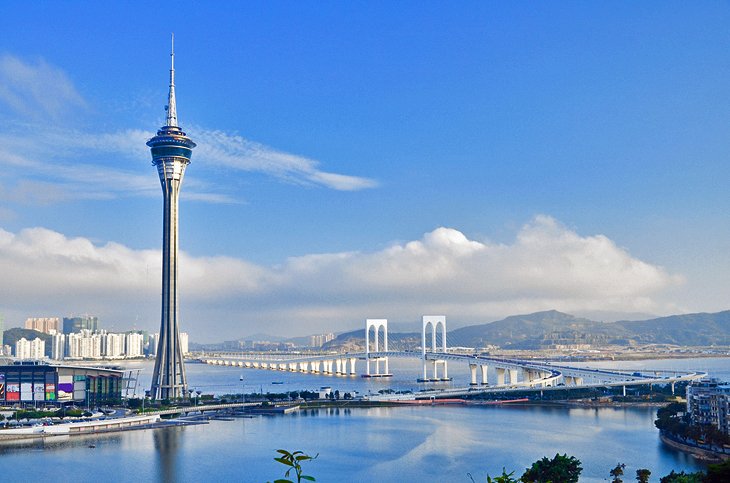
Highlights: The chance to do the world's highest bungee jump, popular restaurants, fantastic views
Part of the massive Macau Tower Convention and Entertainment Centre, the Macau Tower is easily one of the city's most recognizable landmarks, as well as a popular tourist attraction.
Standing 338 meters tall and built for telecommunications and broadcasting, the tower's fun side includes an observation deck boasting phenomenal views over the city, as well as a number of restaurants, theaters, and shopping opportunities.
For thrill-seekers, there's the Macau Tower Skywalk, a breathtaking walk along the outer rim of the observation level, or you can experience the world's highest bungee jump at the 233-meter mark.
Take the Family to the Giant Panda Pavilion

Highlights: Giant Pandas, red pandas, and monkeys housed in an architecturally stunning building
The Giant Panda Pavilion is located on Cotai and is a bit out of the way, but this means crowds are often sparse. It's also one of the best things to do in Macau for families. Step inside the architecturally unique building and marvel at the translucent roof in the shape of a giant seashell. In the wildlife pavilion are several giant pandas, cute red pandas, and an assortment of monkeys.
The animals are most active and easiest to see in the morning, but they also come around about 2pm, which is feeding time. The facility has beautiful koi ponds, gardens, and a children's playground. Entry to the park area is free, but a nominal fee is charged to view the pandas.
Explore the Guia Fortress
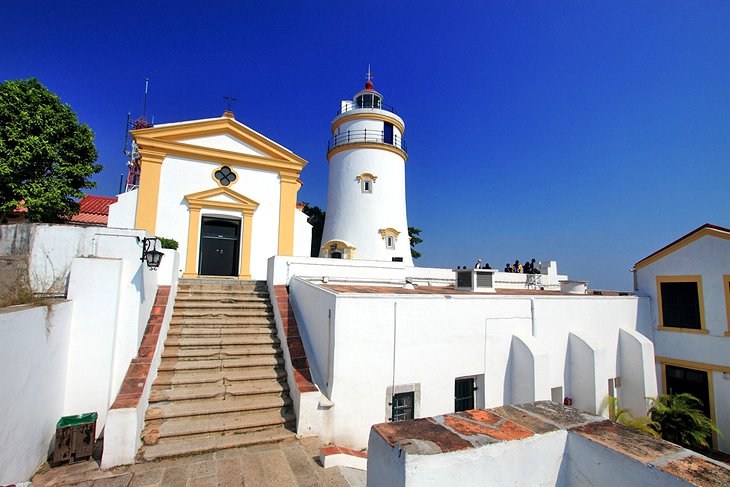
Highlights: Historical fort offering great views, tunnels to explore, 17th-century frescoes
Guia Fortress is an oasis of green in the center of Macao and only a short distance from the high-speed ferry terminal. Access is via hiking paths or a short cable car ride. At the top, you'll find impressive views out over Macau, along with old cannons, a small chapel with nicely preserved frescoes dating from the 1600s, and a 91-meter-high lighthouse (closed to entry).
Go underground and explore the series of tunnels in the fortress open to the public; some are near the lighthouse, and some are near the cable car entrance. Located throughout the fortress are exhibits and photos detailing the military history of the area.
Coloane Island and Hac Sa Beach
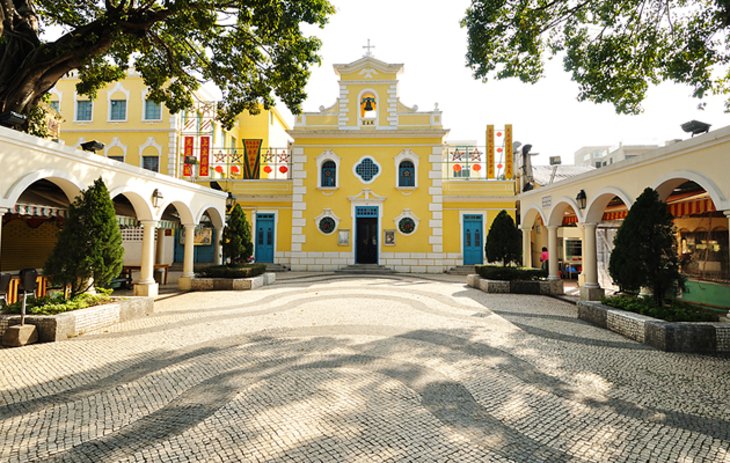
Highlights: White sand beaches, pine forests, historical architecture, and the Tam Chin Temple
Joined to the mainland by a bridge and causeway, the island of Coloane lies to the south of the Macau Peninsula, beyond the island of Taipa, and should be included in your Macau itinerary.
Visitors are often pleasantly surprised to learn Coloane is an island of pine forests, eucalyptus groves, tropical vegetation, and farmland, as well as boasting a number of beautiful beaches of fine white sand.
Of these beaches, the best known is Hac Sa Beach on the east side of the island. Part of Coloane Park with its Chinese pavilions and tropical flora, the beach area includes a recreation complex with facilities for swimming, tennis, mini-golf, and other fun amusements.
Another beach of note is Cheoc Van Beach at the south end of the island. Also of interest is the Tam Chin Temple, noted for its whalebone model of a ship with a wooden dragon's head, and Coloane Village, a mix of old Chinese and colonial buildings with a charming little chapel dedicated to St. Francis Xavier, in front of which is a monument commemorating a successful Portuguese action against pirates in 1910.
Take a Day Trip to Taipa Island and Taipa House

Highlights: A notable Buddhist shrine, Taoist temples, the Taipa House Museum, traditional Macanese cuisine
The island of Taipa, to the south of Macau and linked to it by an imposing high-arched bridge, makes for a great day trip. Formerly a Chinese customs post for vessels putting in at Macau and for decades the traditional site of fireworks factories, the town itself contains large numbers of Chinese shops and Portuguese colonial buildings, along with a popular horse-racing track.
Other highlights include the Buddhist Shrine of the Four Faces and Pak Tai Temple, built in 1844 and notable for its rich decoration and its two life-size guardian figures. Of the island's many smaller temples, Tin Hau is the best known and was built some 180 years ago (it's notable for its highly ornamented shrine containing a figure of the goddess).
A must-see is the fully restored colonial Taipa House, home to the Taipa House Museum with its interesting displays of furniture typical of old Macau homes.

Kun Iam: The Temple of the Goddess of Mercy
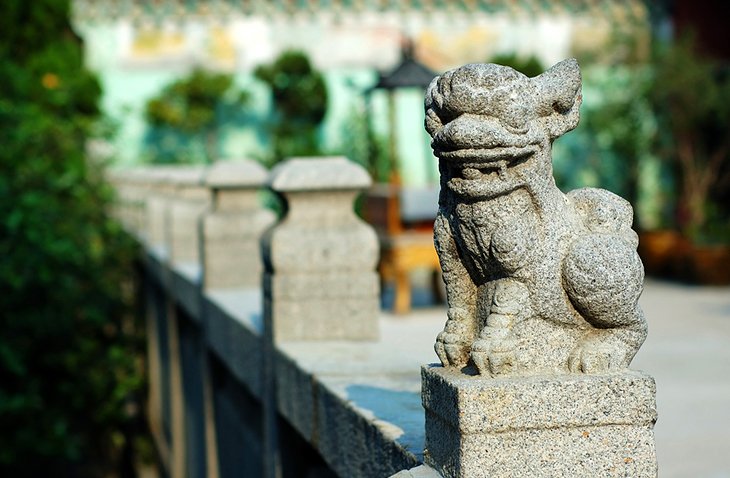
Highlights: A beautiful courtyard, quiet gardens, three notable figures of Buddha
Dedicated to the goddess of mercy, the current Kun Iam Temple was built in 1627, although references to a temple on the site can be traced back to the Yuan dynasty of the 13th and 14th centuries. In the entrance hall are three figures of Buddha representing the Past, Present, and Future, while another hall contains a figure of the goddess of mercy flanked on either side by nine Buddhas.
Also of note is the temple's beautiful courtyard garden where on July 3rd, 1844, the first-ever treaty between the US and China was signed. Other interesting features include porcelain reliefs and roof turrets with figures dating from the Ming period, and a unique gilded Buddha statue said to resemble famed Venetian, Marco Polo.
Behind the temple is a large Chinese garden with its Tree of the Loving Couples, where young lovers offer prayers for good fortune in their future lives. Also worth a visit is Lin Fong Miu Temple, a Taoist site built in 1592 that long served as a staging point for travelers to China.
Ride the Free SkyCab at Wynn Palace Resort
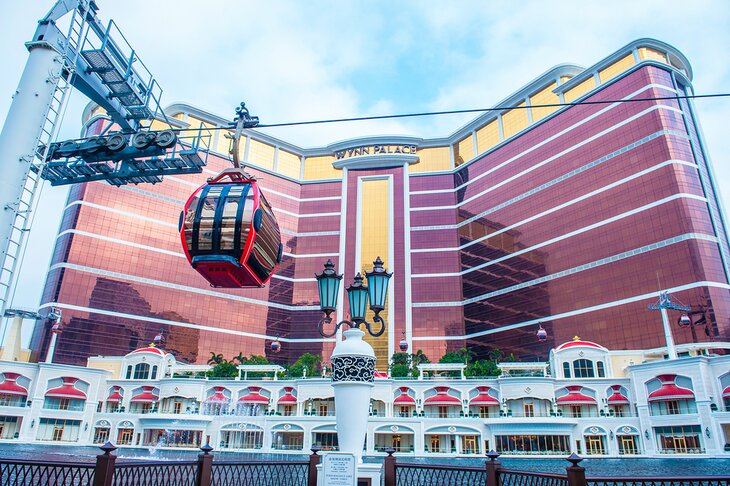
Highlights: Dancing fountains, music, a dragon surprise, views out over the Coati Strip
One of the fun and free things to do in Macau is a cable car ride at the Wynn Palace. The Skycab ascends over Performance Lake, and if you time it right, you'll be able to see the dancing fountains in their full majesty. A narration, complete with music, explains the sights as you glide along.
The most dramatic time to ride the Skycab is in the evening, as the neon lights of the Coati Strip are in their full glory. Be sure to watch out for the giant dragon and his glowing red eyes when the ride takes a sudden turn.
The trip takes about five minutes and ends inside the hotel. You can ride as many times as you want but will need to queue in line each time. The ultra-modern Skycabs seat six people and are fully air-conditioned.
Best Time to Visit Macau
The best time to visit Macau is in the fall in the months of October, November, and early December. At this time of year, the humidity is low and the days are warm and sunny but not too hot. You can count on high temperatures of about 26 degrees Celsius. The city is busy with marquee events including the Macau Grand Prix and the Macau International Fireworks Display Contest.
The early spring months of March and April are also good times to visit, with cooler temperatures and generally dry conditions. May is the wettest month, and September tends to be risky, with the chance of typhoons.
Summer, which includes June, July, and August, is peak season in Macau despite it being hot and humid. The city is crowded and accommodation prices are at their highest, but if you want to hit one of the beaches on Coloane Island, it's perfect.
Winter, generally regarded as January and February, is surprisingly cool with temperatures in the range of 12-18 degrees Celsius.
More Related Articles on PlanetWare.com
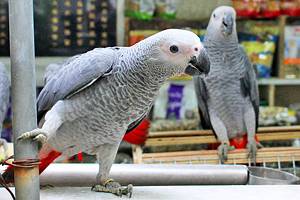
Hong Kong: Visiting Macau goes hand in hand with visiting Hong Kong. Once you've finished seeing the sights in Macau, be sure to leave time to explore the top attractions in Hong Kong. One of the highlights for tourists is the street markets. If you've had your fill of busy streets, consider heading out on some of Hong Kong's top walks and hikes or enjoy some time at one of the area's beautiful beaches.



